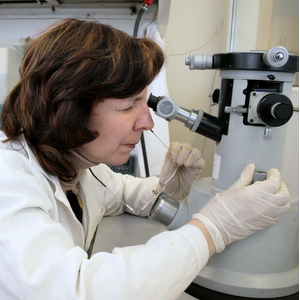Russian scientists have developed a new simple method of laser nanofabrication, which makes it possible to produce sensor substrates for chemical, biological and environmental studies, as well as to obtain new materials – metasurfaces. The results of the study are published in Applied Surface Science journal.
Metasurfaces are new, artificially designed materials created to control electromagnetic waves of various types. In a certain way they change the amplitude or phase of the incident light and are also able to control its polarization.
Researchers of P.N. Lebedev Physical Institute (Moscow), the Institute of Automation and Control Processes of Far Eastern Branch of the Russian Academy of Sciences / FEFU (Vladivostok) and Samara National Research University developed laser nanofabrication technology using diffractive optical elements made on quartz substrates.
According to the scientists, using a new, simple and highly reproducible method of ultrafast laser nanofabrication, it is possible to produce various sensor substrates that work on the effects of surface-enhanced infrared (IR) absorption. This is especially important for the analysis of chemicals and bioassays in many areas of science and life.
"The method makes it possible not only to make cost-effective production of various functional metasurfaces, but also to provide their exact characterization using conventional laboratory spectroscopic instruments," – Professor of Samara University Technical Cybernetics Department Svetlana Honina said to RIA Novosti.
The scientists reported that they were able to demonstrate high-performance printing of microholes on the surface of thin films of gold at a speed of over 10⁷ elements per second.
These two key technologies used by scientists are laser ablation (the removal of matter from the surface by a laser pulse) of thin metal films and the formation of laser beams in the form of a set of light spots.
"Such an ablative laser nanofabrication using modern pulsed laser systems has become a relatively cheap," clean "and high-performance fabrication technology for nanostructured sensory meta-coatings and metasurfaces", – Professor Honina said.
Diffractive optical elements manufactured by Samara University scientists provide a unique tool for the formation of so-called structured laser beams, which makes it possible to take better control of the laser ablation process and do the processing of materials in the right way.
Samara University scientists were among the first to deal with this issue. The University School of Diffraction Optics has been existing for over 30 years under the guidance of Academician of the Russian Academy of Sciences Victor Soifer. Using the developed software, the specialists calculated and then fabricated diffractive optical elements, which made it possible to divide the initial laser beam into many beams.
The research is supported by the grant of the Russian Science Foundation.
In the future the researchers are planning to accelerate and reduce the cost of the process of manufacturing metasurfaces with the desired properties and make the production of various active and passive optical elements and sensors more affordable. To do this, they will solve the problem of reaching the threshold ablation nanofabrication speed of about 10⁹ structures per second with a spatial resolution of 1 micrometre.
Source: ria.ru
 RU
RU  EN
EN  CN
CN  ES
ES 